Last week, the LEGO Group shared its performance report from the first half of 2021. Consumer sales grew 36%, revenue grew 46% to DKK 23 billion, operating profit grew 104% to DKK 8 billion, and net profit grew 140% to DKK 6.3 billion. Also, free cash flow was strong at DKK 5.8 billion, and the company made market share gains globally, as well as at their largest markets. With the LEGO Foundation, donations of DKK 1.5 billion went to support children’s development via learning through play. Details below.

Billund, September 28, 2021: The LEGO Group today reported first-half earnings for the six months ending June 30, 2021. Revenue for the period grew 46% to DKK 23 billion compared with the same period in 2020. Consumer sales grew 36%, outpacing the toy industry and driving market share growth globally and in all major markets.
Operating profit was DKK 8 billion, an increase of 104% compared with the first half of 2020, despite an ambitious program of strategic investments to support growth in the long term.
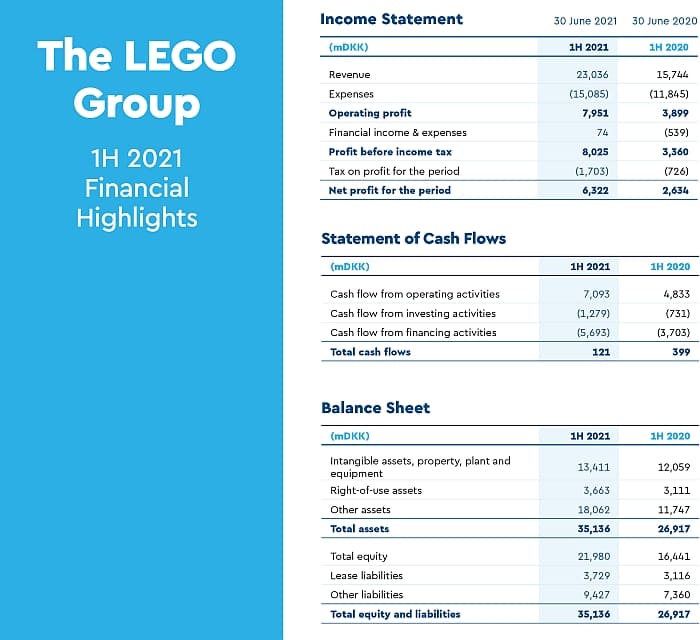
The LEGO Group CEO, Niels B. Christiansen said: “We are very pleased with the progress we made across all areas of the business during the first half. Our performance was driven by strong demand for our portfolio, which has attracted new builders to the LEGO brand. Our year-on-year growth benefited from fewer COVID-related restrictions compared with 2020 as our factories operated uninterrupted and the majority of retail stores re-opened. We also saw the benefits of multi-year investments in e-commerce, product innovation, and a global supply chain network. Our strong financial performance now allows us to accelerate strategic investments in sustainability and digitalization. We are especially grateful for our amazing team. Despite all the challenges and uncertainties of the past six months, they worked extraordinarily hard to bring play to more families around the world.”
ALL MARKET GROUPS GREW DOUBLE DIGITS
All market groups delivered double-digit consumer sales growth, which was driven by excellent execution and a diverse portfolio that appealed to builders of all ages and interests. Top-performing themes included LEGO City, LEGO Star Wars, LEGO Harry Potter, LEGO Creator Expert, and LEGO Technic.
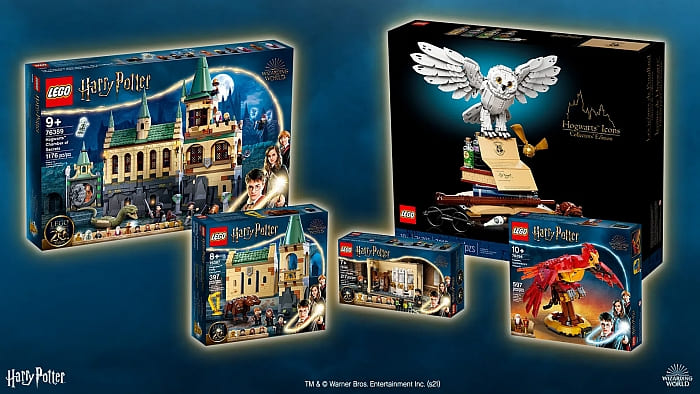
Operating profit more than doubled despite significant investments in major long-term initiatives such as a new retail store format, e-commerce capabilities, an enterprise-wide digital transformation, and efforts to make products and operations more sustainable. Operating profit was also offset by increased freight and raw material costs.
Christiansen said: “As we look ahead to the second half of 2021, we continue to see strong demand for our products. Longer-term, we expect top-line growth to stabilize to more sustainable levels as people return to pre-pandemic spending patterns. This trend, combined with our plans to accelerate re-investments into the future of the business, is expected to result in more normalized profit levels moving forward. Our investments are designed to create a sustainable future for the business and advance our mission to have a positive impact on children and the world they will inherit. Digitalization and sustainability will have an especially critical play in this, and we are extremely pleased with the progress our teams are making in these areas. We will also continue to develop our play experiences and brand expression so that LEGO play is diverse and welcoming for all.”
BUILDING A SUSTAINABLE FUTURE
The company made progress against its ambition to create more sustainable products. In June, it unveiled a prototype brick made from recycled single-use PET bottles, an important step in reducing its reliance on non-renewable raw materials. It also completed a successful trial of paper bags designed to replace single-use plastic in boxes and will begin phasing in the new paper packaging from early 2022. This development ensures the Group remains on track to make all packaging 100% sustainable by 2025.
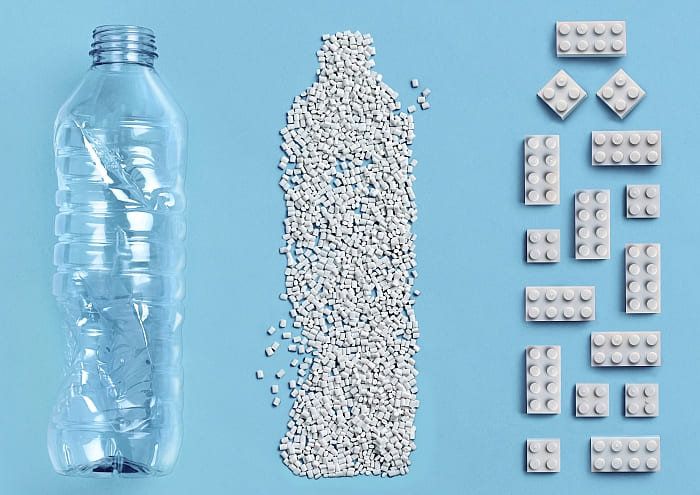
MEMORABLE BRAND EXPERIENCES ONLINE & IN-STORE
The LEGO Group’s investments in its physical and digital retail channels paid off in the first half. E-commerce sales across our own and partners’ platforms grew 50% compared with the same period last year.
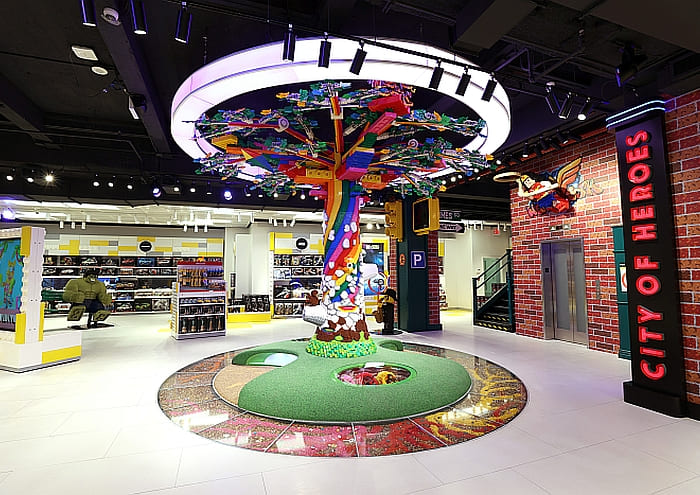
The company also launched a new retail store format, which will be introduced to around 60 stores during the second half of 2021. The format was unveiled at the opening of a new flagship store in New York City in June and is designed to create immersive, playful, and memorable brand moments.
The LEGO Group continued to expand its global retail footprint opening more than 60 new LEGO branded stores in the first half of 2021, more than 40 in China. This brings the total number of LEGO retail stores as of June 30, to 737, with 291 of those located in China.
During the second half of 2021, the company will accelerate investments in a multi-year, enterprise-wide digital transformation. New digital platforms, products, and ways of working will support a long-term ambition to digitally enable the LEGO brand to create fantastic experiences for children, shoppers, partners, and employees. Digital talent hubs were opened in Shanghai and Copenhagen in addition to the company’s headquarters in Billund and hub in London to support this effort.
POSITIVE IMPACT ON FUTURE GENERATIONS
The company continued to help children around the world develop via learning through play. More than 1.2 million children benefited from product donations and local community engagement activities.
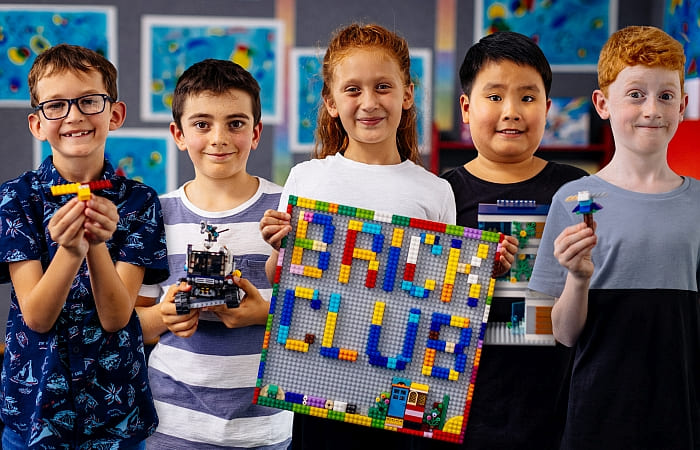
Year to date, the LEGO Group with the LEGO Foundation, which owns 25% of the LEGO Group, pledged more than DKK 1.5 billion (US$235 million) in donations to agencies that support children and families, especially those in need. This included DKK 940 million (US$150 million) for COVID relief with a focus on children’s health and development, DKK 140 million (US$23 million) to support children’s education, DKK 100 million (US$15.7 million) to agencies working with families impacted in Haiti and Afghanistan, and funding for programs which advance learning through play in communities where the LEGO Group operates.
Christiansen said: “The single biggest motivating force for everyone at the LEGO Group is knowing we can have a positive impact on future generations. Whether it’s in times of acute need or helping a child develop new skills that will last a lifetime, LEGO play and the LEGO brand can, and will, make a difference. We are proud to be in this position and are committed to doing all we can to continue to inspire and develop the builders of tomorrow.”
What do you think? Did you notice any interesting details from LEGO’s half-year report? Feel free to share your thoughts and discuss in the comment section below!
And you might also like to check out the following related posts:












With a profit margin and sales increase like that they should dramatically cut their prices. Make Lego sets for children of all income backgrounds. Lego is greedy. No one piece of Lego is worth more than a few cents. They need to dump all the shares, turn private, and run it like an independent small business. Stock market companies are evil, which is why I am selling off all my stocks. My father left me with the curse of a ton of money and I hate it. Spending it in ways he would disapprove. Hence all the Lego I buy from auction houses and other non-Lego benefitting purchase points. Also no credit used here ever. Cash for all purchases.
First, LEGO is a private company, and they are not part of any stock market. Given how successful they’ve been as a private company, I doubt they will go public anytime soon.
Next, although I agree LEGO has gotten rather greedy recently and many sets are indeed overpriced, LEGO does still make sets for people with a wide range of incomes. Roughly 75% of sets this year cost less than $50 (USD), and 58% cost $20 or less. Thus, there is still LEGO available for almost everyone. Cutting prices won’t change that.
Additionally, I’m glad you are one of those ultra-rich types in a position to complain about having too much money. Maybe you could give some to me: I certainly have need of it at present. And charity is almost always a good way to spend money.
I’m also glad you understand economics, so you know that any legitimate LEGO products you buy, from any source, had to be purchased from LEGO at some point (or else donated by LEGO), meaning that LEGO still made the money you’re so desperate not to give them.
To clarify my position, I am not a LEGO defender and have little interest in bickering about how the LEGO company should be run. I merely wanted to ascertain (with some added sarcasm) that you knew your comment was poorly thought out.
Anyways, on topic, while the numbers look good, it is better to hear that Christiansen recognizes that this year is anomalous and doesn’t expect the same results in the future. There shouldn’t be any overreactions next year, then. Still, I recall that LEGO let go a bunch of people last year because the company had a 1% decrease in profits or something. Maybe now might be a good time to rehire those people….
Ha! Everyone is grim today? Nice to have you over, by the way! 🙂
If you hate having a ton of money, I will GLADLY remove that burden from you 🙂
LEGO is a privately held company anyway, so WTF are you even on about?
I’m happy to see that they are doing well. No doubt because of people looking for new hobbies during the pandemic. I’m also happy to see that Creator Expert made one of the top performing themes. I suppose most of the adult oriented sets fall in this category now? (Except for Ideas, Art, etc.)
I was surprised to see creator expert on the list. I thought they said they retired that theme. I’m not complaining, just surprised.
I find LEGO’s sustainability efforts interesting. LEGO doesn’t end up in landfill (aside from what gera in the vaccum -lol). The durability and widespread usefulness of the product make it something people keep to pass down to generations or donate or sell to others. That said, I am interested to see how the recycled materials hold up over time, especially for current known issues like the fragility of reddish brown and dark red bricks and coloration problems with white bricks.
The plastic bag to paper bag change makes me laugh. It wasn’t but a few decades ago people were screaming about cutting down all of the trees so paper was replaced with plastic. This has come full circle.
Yes, LEGO sets and pieces are naturally recycled by passing them on from generation to generation. And they are also very durable and long-lasting. I have LEGO inherited from my grandparents! 😀
My understanding is that for the paper bags, they are planning to use recycled paper. The biggest issue with the plastic bags they are using now is that they are not reusable for really anything, and not recyclable in many places. Recycled paper does feel like a better option.
LEGO made an announcement (I think it was last year), that the issue with the reddish-brown/dark-red pieces was identified and they fixed it. Of course, there are still a lot of sets in circulation that include those parts, so there is a perception that it’s still a problem. But newly released sets shouldn’t have this issue, and for affected sets, replacement parts can be requested.
I think the fragility of certain colored bricks generally was a North America problem only, and the situation didn’t really happen in Europe.
Yes, that’s my understanding as well. The issue was happening at the factory in Mexico, which is where we get our LEGO from in North America.
LEGO is a private company with VERY HIGH profit margins. As others have pointed out, they could afford to lower prices, or at least not keep raising them.
Maybe it’s time for more “starter sets” at the $10 price point. They could do this in several themes. The same is true for supplementary sets – room furnishings, street scenes, etc.
I’m curious what it costs to make a basic city minifigure? Why can’t they sell 3-packs for $5?